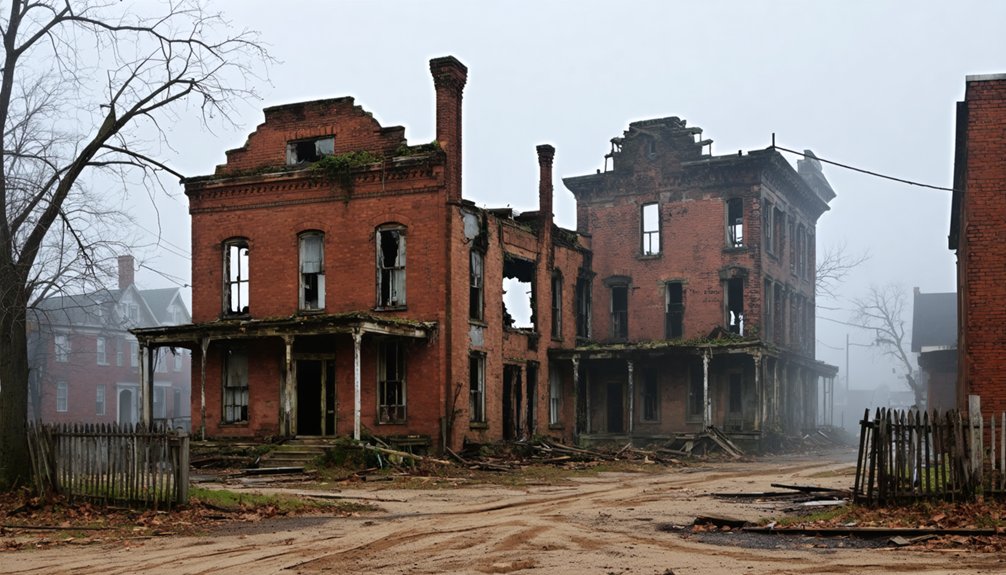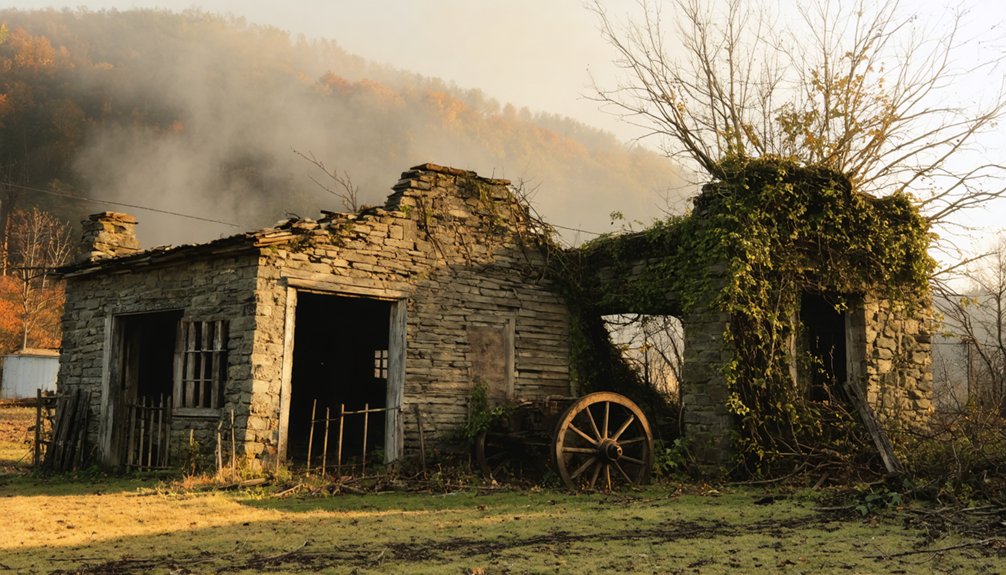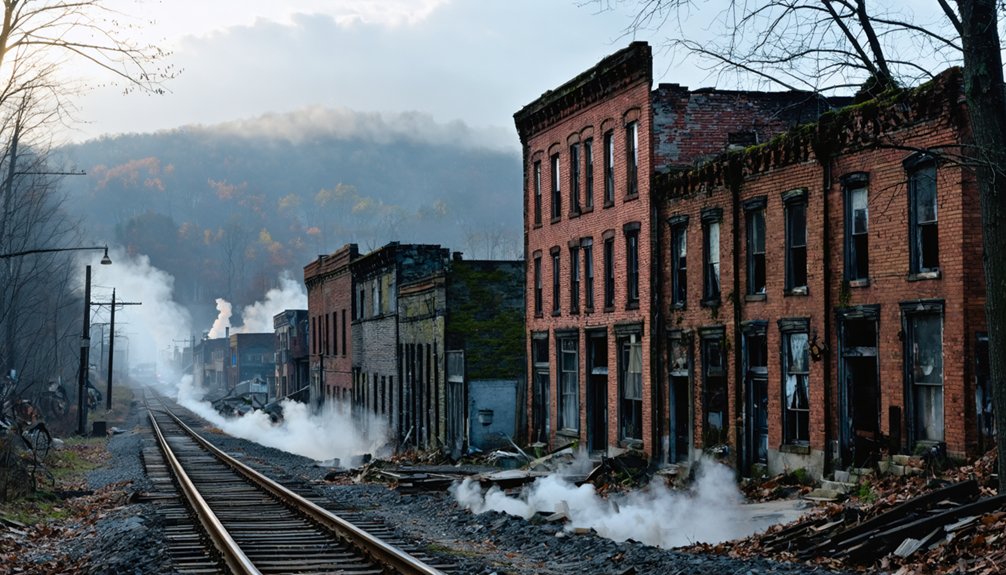You’ll discover America’s haunting Civil War-era ghost towns across diverse landscapes. Cahaba, Alabama sits abandoned after serving as the state’s first capital and a Union prison. Bannack, Montana evolved from vigilante-ruled boomtown to territorial capital. St. Elmo, Colorado preserves original structures despite devastating fires. Centralia, Pennsylvania smolders with underground fires that forced mass evacuation. Bodie, California remains deliberately frozen in “arrested decay” since the 1800s. These spectral settlements offer windows into our nation’s most divided period.
Key Takeaways
- Cahaba, Alabama served as a Civil War prison camp called Castle Morgan before being abandoned and now exists as an archaeological park.
- Bannack, Montana experienced political divisions during the Civil War era before its eventual abandonment after being bypassed by railroads.
- Civil War-era ghost towns often declined due to resource depletion, natural disasters, or changing transportation routes.
- Many abandoned Civil War settlements preserve original structures, offering visitors glimpses into 19th-century American life.
- Ghost towns like Centralia demonstrate how industrial accidents and government failures can lead to complete community abandonment long after the war.
Cahaba, Alabama: The Forgotten First Capital Reclaimed by Floodwaters
When standing at the confluence of the Alabama and Cahaba Rivers today, you’ll find little evidence that this serene, overgrown landscape once hosted Alabama’s first seat of government.
Cahaba history reveals a town doomed by its geography—established as the state capital in 1820 through Governor William Wyatt Bibb’s political maneuvering.
Flooding impacts repeatedly devastated this ambitious settlement built on a floodplain. The rivers that initially promised commercial prosperity ultimately sealed Cahaba’s fate. By 1826, the capital relocated to Tuscaloosa amid health concerns and environmental challenges.
During the Civil War, Cahaba briefly flourished again, housing Castle Morgan prison where Union soldiers endured deplorable conditions. The camp commander attempted to maintain humane treatment despite the overwhelming number of prisoners. After the war, it earned the nickname Mecca of Republicans as freedmen gathered for political meetings in the old courthouse. The catastrophic 1865 flood accelerated abandonment, transforming the once-promising capital into a freedmen’s settlement before nature reclaimed it entirely.
Now preserved as Old Cahawba Archaeological Park, these ruins stand as silent witnesses to ambition undone by water and war.
Bannack, Montana: From Gold Rush Boomtown to Civil War Outpost
Although the Civil War divided the nation in 1862, fortune seekers in the western territories pursued wealth rather than ideology when gold was discovered at Grasshopper Creek on July 28 of that year.
Within months, Bannack’s population swelled to 400, peaking at 5,000 in 1863. The settlement’s political divisions manifested geographically between Jeff Davis Gulch and Yankee Flats. Miners earned approximately eight dollars per day for their grueling work in the early days of Bannack.
Gold mining operations thrived despite dangerous conditions. The town’s Assay Office became renowned for evaluating gold that was 99% pure. As lawlessness escalated with approximately 100 travelers murdered in 1863, vigilante justice emerged as the dominant form of social control.
Amid deadly frontier chaos, Bannack’s citizens took justice into their own hands when formal law failed them.
The Vigilance Committee executed 22 individuals—including Sheriff Henry Plummer—in what historians call “the deadliest episode of vigilante justice in American history.”
Bannack briefly served as Montana Territory’s first capital in 1864 before declining when railroads bypassed the town.
St. Elmo, Colorado: The Mining Town That Time Forgot
Tucked away in Chalk Creek Canyon near the Continental Divide, St. Elmo stands as a monument to Colorado’s mining history.
Originally called Forest City, this settlement was established in 1880 after valuable silver deposits were discovered in 1875. The town flourished with a population of 2,000, boasting hotels, restaurants, and over 150 mine claims.
Unlike many ghost towns reduced to rubble, St. Elmo’s preservation is remarkable.
Despite the devastating 1890 fire and the railroad’s discontinuation in 1922, many original structures remain intact. The Mary Murphy Mine, which produced $60 million in gold, sustained the town until 1936. The town’s sharp decline was accelerated by the silver crash of 1893 that devastated mining economies throughout Colorado.
Today, this National Register Historic District exemplifies exceptional ghost town preservation, offering visitors a glimpse into the compressed timeline of a typical Rocky Mountain boomtown’s rise and fall. Visitors can explore the town’s 43 surviving structures, including a restored schoolhouse and town hall that showcase its rich historical significance.
Centralia, Pennsylvania: The Town Still Burning Underground
Beneath the crumbling streets of Centralia, Pennsylvania, an inferno has raged unchecked for over six decades, transforming a once-thriving coal mining community into America’s most notorious environmental disaster zone.
The Centralia fire ignited in 1962 when burning trash in an abandoned strip mine penetrated unsealed coal seams below. Despite initial attempts to smother the blaze with water and clay, the flames found sanctuary in the labyrinthine network of abandoned mines.
The underground spread has now consumed over six square miles, advancing 75 feet annually through multiple pathways. Scientists predict this environmental catastrophe will continue burning for another 250 years based on available coal reserves.
You’ll find few traces of the town’s 1,500 former residents. Toxic gases, dangerous sinkholes, and government condemnation drove most away.
The remaining inhabitants live with severe restrictions in a place that’s been effectively erased—a stark monument to industrial negligence and governmental failure. Only seven residents were permitted to remain until death after Pennsylvania attempted eminent domain on the condemned land.
Bodie, California: Preserved in “Arrested Decay” Since the War Between States
Unlike Centralia’s ongoing environmental disaster, Bodie, California stands as a remarkably preserved relic of America’s gold rush era, its weathered structures frozen in what preservationists call “arrested decay” since the Civil War period.
William Bodey’s 1859 gold discovery transformed this Eastern Sierra settlement into a boomtown of 10,000 by 1879, though its founder never witnessed this prosperity, perishing in a blizzard months after arrival.
Bodie’s founder discovered gold but died in winter’s brutal grasp, never seeing the boomtown his find created.
Bodie history reveals a notorious settlement where:
- Violence occurred daily across 60 saloons and gambling halls, earning contemporary descriptions as “a sea of sin”
- The population collapsed following resource depletion, with the final mine closing in 1942
- Only 10% of buildings survived the devastating 1932 fire that nearly erased this slice of American frontier
At its economic peak, the town produced an estimated total of $90-100 million in gold ore throughout its mining history. Today, visitors can experience an authentic glimpse into the past as they walk among the remaining historical buildings.
Ghost town preservation efforts secured Bodie as a National Historic Landmark in 1961.
Frequently Asked Questions
Are These Ghost Towns Legally Accessible for Independent Explorers?
Many ghost towns on public lands are legally accessible without formal permissions. You’ll need to research exploration guidelines and confirm ownership status before visiting to avoid trespassing violations.
What Paranormal Activities Have Been Documented in These Abandoned Towns?
Like spectral echoes trapped in time’s amber, you’ll encounter documented paranormal investigations revealing apparitions at Devil’s Den, disembodied voices in Vicksburg, ghost sightings near mass graves, and physical anomalies across these locations.
How Do Locals Feel About Tourism in These Historical Sites?
You’ll find local sentiments toward battlefield tourism are mainly positive, as residents recognize tourism’s economic impact through job creation, increased tax revenue, and business growth without substantial infrastructure demands.
Can Artifacts Be Collected From These Abandoned Towns?
No, you can’t legally collect artifacts. Ethical considerations and artifact preservation laws prohibit removal from federal lands, while private property requires explicit written permission—violations incur substantial penalties including imprisonment.
Do Any Descendants of Original Residents Still Visit Regularly?
Like pilgrims to sacred ground, descendants regularly make visits to these sites. You’ll find many families participating in cemetery cleanups and reunions, preserving their ancestral connections and historical significance through continued engagement.
References
- https://www.loveexploring.com/gallerylist/131658/abandoned-in-the-usa-92-places-left-to-rot
- https://en.wikipedia.org/wiki/Wikipedia:WikiProject_Ghost_towns
- https://www.geotab.com/ghost-towns/
- https://m.dresshead.com/files/scholarship/Documents/Ghost_Towns_Lost_Cities_Of_The_Old_West_Shire_Usa.pdf
- https://www.mentalfloss.com/geography/american-ghost-towns-can-still-walk-through
- https://vitabrevis.americanancestors.org/2020/12/ghost-towns
- https://www.visittheusa.com/experience/5-us-ghost-towns-you-must-see
- https://en.wikipedia.org/wiki/Wikipedia:WikiProject_Ghost_towns/Assessment
- https://www.christywanders.com/2024/08/top-ghost-towns-for-history-buffs.html
- https://en.wikipedia.org/wiki/Ghost_town



